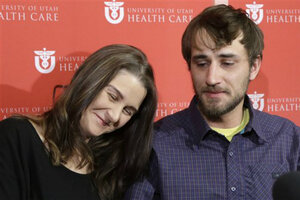Utah avalanche survivor meditated, had a serene feeling of safety
Utah avalanche survivor Elizabeth Malloy meditated and felt serene about surviving before passing out under 18 inches of snow. Her boyfriend dug her out and revived her.

Utah avalanche survivor Elizabeth Malloy made it out from under 18 inches of snow with the help of her boyfriend. The couple discussed their ordeal at a press conference Jan. 16.
AP
Salt Lake City
A 43-year-old Utah woman who survived an avalanche says she felt a 'strange serenity' while trapped under the snow before she went unconscious.
Elisabeth Malloy suffered frost bite in her toes and fingers, but lived to tell her harrowing story thanks to her boyfriend, avalanche rescue beacons, a skier that wandered by, and avalanche rescue teams.
She and her boyfriend and ski partner, 30-year-old Adam Morrey, spoke at length about their experience during a press conference yesterday afternoon at University Hospital in Salt Lake City. They said they were fortunate to be alive after they triggered and were engulfed by a 700-foot wide avalanche while skiing in the mountains east of Salt Lake City on Jan. 12.
Ms. Malloy said it felt like a water slide as she slid face first on her stomach down the mountain in the avalanche. She meditated, breathed slowly, and told herself that it wasn't her time to die during the few minutes before she lost consciousness while buried about 18 inches into the snow.
"It was surreal, as quiet and as embryonic without being water that I could imagine," said Malloy, a pediatric nurse. "I had this feeling that I was going to be fine."
She said she remembered being awoken by "sweet kisses" from Morrey, then feeling very cold and asking for a "hot toddy."
Morrey, who had skied downhill about 10 to 15 feet before being bowled over the slide, emerged with his head and chest out of the snow. After Malloy failed to answer his calls, he frantically shimmied out of the snow and began searching for her. After several long minutes, Morrey found Malloy using avalanche rescue beacons they were both wearing.
Using an avalanche shovel, Morrey hit her foot and then found the rest of her body. She was breathing but unconscious for a bit before she stopped breathing. Morrey performed CPR on her. She didn't have her ski boots and had lost her gloves. Morrey grabbed extra clothes she had in her backpack and put them on her to keep warm.
Another skier came by and helped the two make their way down the mountain — Morrey and the other man on skis and Malloy on a plastic bag with one ski boot. After calling to initiate a rescue, the man helped them slide their way down until a rescue helicopter spotted them about 2 ½ hours later.
They were taken to University Hospital in Salt Lake City. Malloy has been there since receiving treatment for her frostbite in the burn unit.
Morrey said they both have years of experienced backcountry skiing, and that they knew about the considerable avalanche danger that day.
"Our judgment was overwhelmed by the pursuit of having more fun and skiing the steeper slopes and the great Utah powder," Morrey said.
Malloy said she's glad she was buried and not Morrey because she's not sure she would have been able to be calm enough to pull off the rescue. Both thanked university officials for treating them and to avalanche rescue teams for bringing them to safety. And Malloy vowed to return to the snowy mountains.
"It's who I am," she said. "It's not about the powder turns, it's about the mountains. It's about the hiking, it's about the experience for me. I enjoy being in the mountains, I love snow. I've always considered myself a mountain goat."

